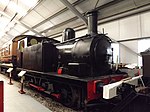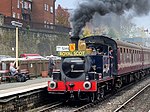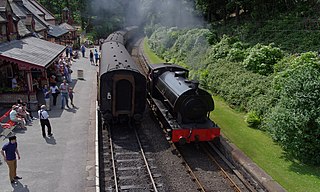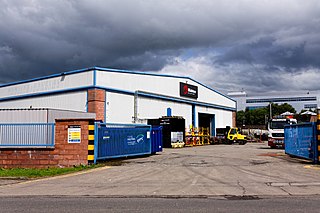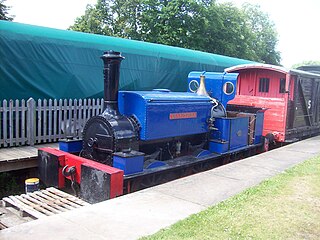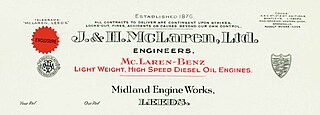| Number & Name | Wheel Arrangement | Image | Current Location | Notes/Status |
|---|
| No. 699 Swanscombe | 0-4-0 ST | 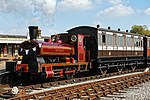 | Buckinghamshire Railway Centre | Built in 1891. The oldest surviving Andrew Barclay locomotive. Painted in pseudo-Metropolitan Railway Red as Brill No.1. Operational, ticket expires in 2023. [4] |
| No. 776 Firefly | 0-4-0 ST | | Northampton and Lamport Railway | Built in 1896. Delivered in June 1899 to Mellingriffith and Co. Ltd. Under restoration. [5] |
| No. 782 Kinlet | 0-6-0 ST | 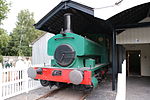 | Blists Hill Open Air Museum | Built in 1896. Worked at Kinlet Colliery. |
| No. 807 Bon Accord | 0-4-0 ST | | Royal Deeside Railway | Built in 1897. Ex-Aberdeen Gas Works. Operational following an overhaul in 2019. |
| No. 880 Glenfield No.1 | 0-4-0 CT |  | Statfold Barn Railway | Built in 1902. Worked at the Glenfield and Kennedy works in Kilmarnock until the 1960s. Moved to RSR from Chasewater Railway. [6] Following death of the owner in 2019, the locomotive was put up for sale and eventually moved to the Statfold Barn Railway, where it was restored and now on static display. |
| No. 885 The Barclay | 0-6-0 ST | | Cambrian Heritage Railways | Built in 1900. Being cosmetically restored. Worked at Eddlewood Colliery until the 1980s when purchased for preservation. |
| No. 945 Annie | 0-4-0 ST | 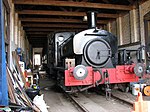 | Whitwell and Reepham Railway | Built 1904. Under overhaul. Worked for S.J. Clave then Charles Roberts & Co. Ltd. Later sold to Yates Duxbury & Sons for work at the paper mill in Heap Bridge in 1930, when withdrawn in October 1974 Annie was the last privately owned steam locomotive in revenue-earning operation. Name comes from a then withdrawn Peckett that worked at the same site. [7] |
| No. 1015 Horden | 0-6-0 ST | | Tanfield Railway | Built in 1904. Ex-Horden Collieries. Carried the same buffer beam when involved in a collision with a LNER Q6. Undergoing heavy restoration at Marley Hill. [8] Received extensive chassis repairs, boiler sent to workshops of Israel Newton & Sons in Derbyshire in late November 2018. New front tubeplate has been manufactured, soon to be fitted, saddle tank is under repairs at Marley Hill. [9] |
| No. 1047 Storefield | 0-4-0 ST | 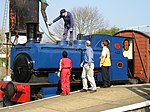 | East Anglian Railway Museum | Built in 1905. Ex-Cargo Fleet Iron Co. Ltd. Overhaul completed in 2013 and returned to steam. |
| No. 1116 NCB 16 | 0-4-0 ST | | Scottish Industrial Railway Centre | Built in 1910. Ex-Dalmellington Iron Company. Cosmetically restored and now on display at the Ayshire Railway Preservation Group base at Engineers Shop at Dunaskin. |
| No. 1147 John Howe | 0-4-0 ST |  | Ribble Steam Railway | Built in 1908. Ordered by Howe's Plaster Works. Currently on static display. [10] |
| No. 1175 No. 8 Dardanelles | 0-6-0 ST |  | Polkemmet Country Park | Built in 1909. Named Dardanelles after the WWI campaign in progress when Polkemmet Colliery opened. Cosmetically restored and on display as a war memorial. [11] |
| No. 1193 | 0-4-2ST | | Tanfield Railway | Built in 1919. A unique type of locomotive, one of four 0-4-2STs built. To Lothian Coal Co. Ltd. Currently unrestored at Marley Hill Yard. [12] |
| No. 1219 Caledonia Works | 0-4-0 ST |  | West Somerset Railway | Built in 1910. Delivered to Stewarts & Lloyds at Clydedale Works. Operational following return to service in 2016. Based at Washford on the West Somerset Railway. |
| No. 1223 Colin MacAndrew | 0-4-0 ST | 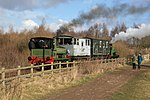 | Mountsorrel and Rothley Community Heritage Centre | Built in 1911. Delivered to Colin McAndrew & Co. Now at the Mountsorrel & Rothley Heritage centre in working condition. |
| No. 1245 | 0-6-0T |  | Lakeside and Haverthwaite Railway | Built in 1911. Built for Carron Iron Company. Restored to working order on the Lakeside and Haverthwaite Railway in CR Livery. [13] |
| No. 1260 Forester | 0-4-0 ST | | Pontypool and Blaenavon Railway | Built in 1911. Delivered to Newport Tinplate Co. Ltd. On display at the Big Pit Mining Museum at Blaenavon. [14] |
| No. 1296 NCB No. 8 | 0-6-0T | | Scottish Industrial Railway Centre | Built in 1912. Cab, bunker, tanks and side rods stolen. [15] |
| No. 1338 NCB No. 17 | 0-6-0T | | Llangollen Railway | Built in 1913. Delivered to Dalmellington Iron Co Ltd. Being restored at the Llangollen Railway [16] for use on the Tanfield Railway. |
| No. 1385 Rosyth | 0-4-0 ST | | Pontypool and Blaenavon Railway | Built in 1914. Worked at Royal Naval Dockyard at Rosyth. Currently operational. [17] |
| No. 1398 Lord Fisher | 0-4-0 ST | 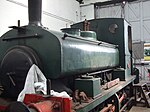 | Yeovil Railway Centre | Built in 1915. Worked at Royal Naval Airship station near Rochester in Kent. Under overhaul. |
| No. 1458 No. 3 Victoria | 0-6-0 ST |  | Bo'ness and Kinneil Railway | Built in 1916 for Ministry of Munitions. Donated by NCB to SRPS in 1978. The locomotive was cosmetically restored in 2019. [18] |
| No. 1598 Efficient | 0-4-0ST |  | Ribble Steam Railway | Built in 1918. Spent entire working life at McKechnie Brothers’ copper smelting works at Widnes. On display in the Ribble Steam Railway's museum. [19] |
| No. 1605 Ajax | 0-6-0T |  | Isle of Wight Steam Railway | Built in 1918. After being built it worked at many locations over a period of years. Awaiting overhaul. [20] |
| No. 1614 NCB No. 19 | 0-4-0 ST | | Scottish Industrial Railway Centre | Built in 1918 and used at Dalmellington Iron Company. Undergoing a cosmetic restoration. |
| No. 1619 Toto | 0-4-0ST | | Mangapps Railway Museum | Built in 1915 and used by Blaenavon Co. Ltd. Under restoration. |
| No. 1659 Stanley No. 32 | 0-4-0 ST | | Tanfield Railway | Built in 1920. Delivered to East Tanfield Colliery. Undergoing overhaul. |
| No. 1680 Nora No. 5 | 0-4-0 ST | 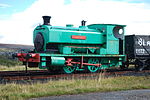 | Big Pit National Coal Museum | Built in 1920 for the Blaenavon Co. Ltd. Now on display in the Big Pit Mining Museum at Blaenavon. |
| No. 1719 No. 2 Lady Nan | 0-4-0 ST | 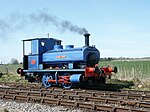 | East Somerset Railway | Built in 1920. Returned to service in 2017 after boiler ticket expired in the same year. |
| No. 1823 Henry/Harry | 0-4-0 ST |  | Pontypool and Blaenavon Railway | Built in 1924. Preserved in 1972 at the Embsay and Bolton Abbey Steam Railway. Now stored at Pontypool. |
| No. 1833 Niddrie | 0-6-0 ST |  | Ribble Steam Railway | Built in 1924. Delivered to Niddrie Collieries. Under restoration. [21] New firebox throatplate being shaped for 1833. [9] |
| No. 1863 | 0-4-0 ST | | Caledonian Railway (Brechin) | Built in 1926. Worked at Anglo-Scottish Sugar Beet Co. at Cupar. Currently operational. |
| No. 1865 Alexander | 0-4-0 ST |  | Ribble Steam Railway | Built in 1926 for Southall Gas Works. Only named in preservation when at Buckinghamshire Railway Centre. Currently on static display. [22] |
| No. 1875 Stanton | 0-4-0 CT | 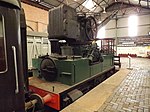 | Midland Railway – Butterley | Built in 1925. Worked at Stanton and Staveley's Ridding yards. Now on static display at Butterley. |
| No. 1889 | 0-4-0 ST | 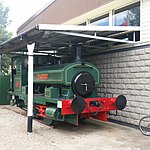 | Grampian Transport Museum | Built in 1925. Worked at Aberdeen Corporation Gas Works. Now on static display. |
| No. 1890 Forth | 0-4-0 ST |  | Fife Heritage Railway | Built in 1926. Delivered to the Scottish Gas Board, spent most of life at Granton Gas Works in Edinburgh. Returned to steam in 2016 and operational on the Fife Heritage Railway. |
| No. 2127 No. 6 | 0-4-0 CT | | Bo'ness and Kinneil Railway | Built in 1942. Delivered to Clyde Alloy Steel Co. at the Craigneuk Works, Motherwell. After closure of this site, it worked at Glengarnock Steelworks as No. 6, the period livery of which it carries today. Donated to Scottish Railway Preservation Society in 1978. Static display. [23] |


















































